Diane: I called the Desert Man, Roberto Penny Cabrera, from the Flores bus station as soon as we arrived in Ica. This turned out to be both a good decision and a bad decision.
It was a bad decision, because the bus station was teeming with noisy people, located on a loud road. Although I am proficient enough with Spanish to handle a simple phone conversation, the ambient noise drowned out any possibility of hearing what the man on the other end of the phone line was trying to say to me. About 5 feet away from the telephone, sat the bathroom custodian looking a bit bored. When I asked him to help me out on the phone, he jumped up, grabbed the phone, and determined that the Desert Man was indeed there and gave me his address.
It was a good decision, because the timing couldn't have been more perfect. Although I didn't know it when I arrived, the Desert Man had just returned from a trip out into the desert and was sitting at the next table sharing a hearty meal with his clients. He had upcoming trips planned, but enough time to squeeze us in. We met up with him again that evening to look at some of the desert artifacts he keeps in his home - some fossils, maps, shark's teeth, etc. Roberto puts his clients into one of two general categories - paleontologist/scientist or tourist. The paleontologists generally have a good idea of what they are looking for and what they need from Roberto. The tourists, on the other hand, aren't always so sure, so Roberto gives them some idea of the geology behind the desert, the distances involved, shows photos, and then gauges their reactions. That is how we ended up in his home.
Roberto's home spoke a bit to his family's history, Ica's history, and perhaps the history of South America in general. It was a colonial mansion on the central plaza. The fancy exterior belied the almost total lack of ornamentation or furniture of any kind immediately inside the entryway and interior patio area. The rooms were large with high ceilings, harking back to the family's wealthy days. One of Roberto's ancestors was a founder of Ica. At one time, the family had a museum, which the government took away from them, ostensibly for the public good. Today nothing remains of the museum; the individual pieces are now in unknown private hands.
Roberto has spent some time in the military. After that he worked for mining companies. And his occupation that most closely resembles what he does now was that of huaquero (tomb robber). Now, he looks like he fits in the desert.
Our first stop was a cemetery in the village of Ocucaje. Roberto pointed out the wall of the graves of newborns and toddlers. The numbers were staggeringly high for such a small town. And then he pointed out that the numbers dropped off to almost nothing in the 90’s. This was when President Fujimori was in power. He actually went about the task of setting up health centers with doctors in every city, town, and village in Peru. This is not to say that he wasn’t corrupt; just that he did something in addition to steal money. The deaths were back up in the 2000’s, once he was out of power. Roberto held that he would make a good president again, even if he had have to govern from jail.
Our first stop in the desert was a well-preserved whale, whose remains are being slowly uncovered by the process of erosion in the desert. We could see the spinal column quite clearly.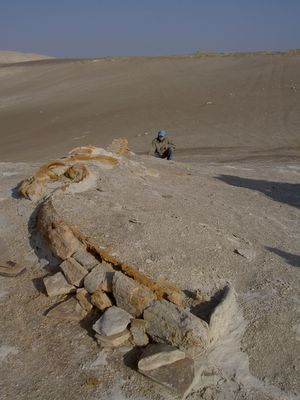
Although Tom came to the desert intent on finding shark's teeth, I came to see a bit of marine and geological history. As Roberto explained it, this part of the desert was once an ancient bay. In the rocky and hilly areas we traverse, it's hard to imagine a bay here, but the wide open sandy/pebbly expanses provide fodder for the imagination.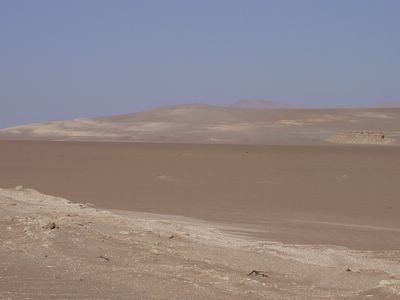
The largest, fiercest marine predators ever known to exist swam freely in this area. The bones of the whale we saw today are bleached-white and interspersed with an orangeish-mustard soil, the result of decomposition of its fleshy, organic material. The orangeish-mustard color is a good indicator, when searching for fossils.
At this point in geological history, the primary force of erosion here is the wind, since it pretty much doesn't rain here and there are no rivers. So the wind blows away the sand, leaving small bumps in a layer of sediment.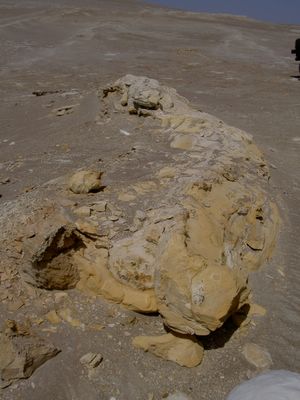
Or bones start to reveal themselves amongst the pebbles.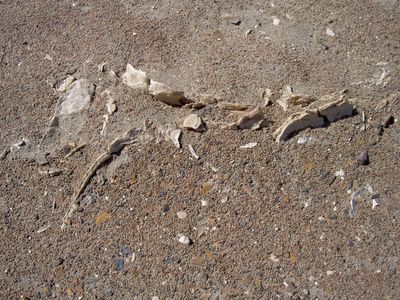
Over time, more and more of the animal remains are exposed, revealing skeletons, decomposed flesh, and shark's teeth. The wind also blows sand leaving unending panoramas of partially-exposed, visually-appealing rock formations. These formations may have been the result of erosion caused by ancient water channels.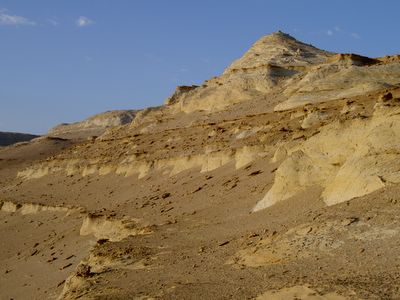
Layers of sedimentary rock are everywhere, the remains of shells and bones built up over time.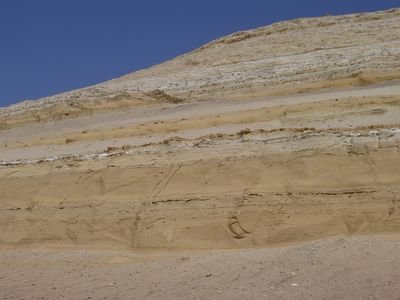
We are surrounded by a huge variety of landscapes, yet none of them include vegetation or animal life as far as I can tell without a microscope.
We set up camp, which consists of taking the lawn chairs off the roof of the pickup and setting them up around the fire pit.
DONE.
Tents aren't needed here in such an arid area. The sleeping bags come out only as the desert cools down. Roberto starts a fire by dousing a couple of blocks of wood with kerosene, spraying them with fire starter, and lighting them with a lighter.
DONE.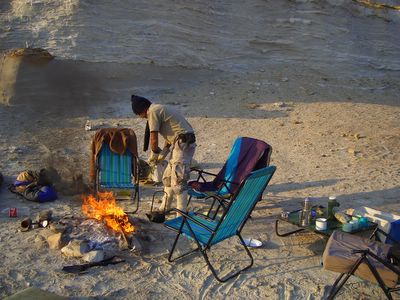
The kids are totally dazzled, having only been exposed to the more environmentally-friendly and arduous back-country methods of starting fires. For us that means scavenging for firewood, building tenuous structures made of different size branches, fanning the small flames, and gradually feeding the fire larger pieces of wood as it grows. I was dazzled by the really cool, dense piece of wood that burned in glorious patterns for most of the evening.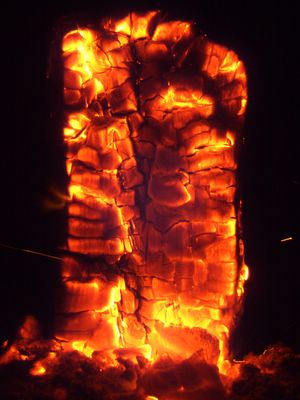
Although Roberto appears to live on jerky and Coca Cola in the desert, he did break out some canned food for dinner. He doesn't believe in cooking in the desert, not based on high moral principles, but based on his experience that many people get sick, when they accidentally eat calcium carbonate that blows into their food as they cook it (Tom says its the magnesium sulfate, but I suppose it just boils down the desert dust). Now here we are in 100% agreement, albeit for different reasons. I never cook, when I camp - too much prep-time, clean-up, and additional gear to tote around. Tonight the kids learn how to heat canned beans over a fire. I make sandwiches. According to Roberto, the adventure starts tomorrow.

1 comment:
I feel as though I'm right there with you, Diane.
Post a Comment